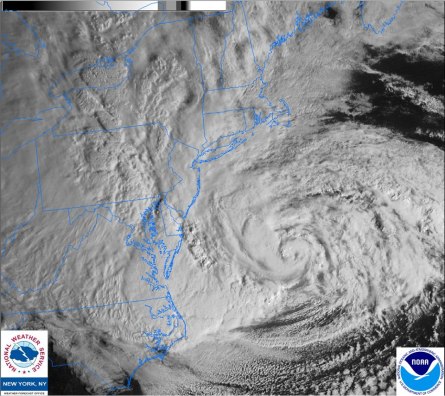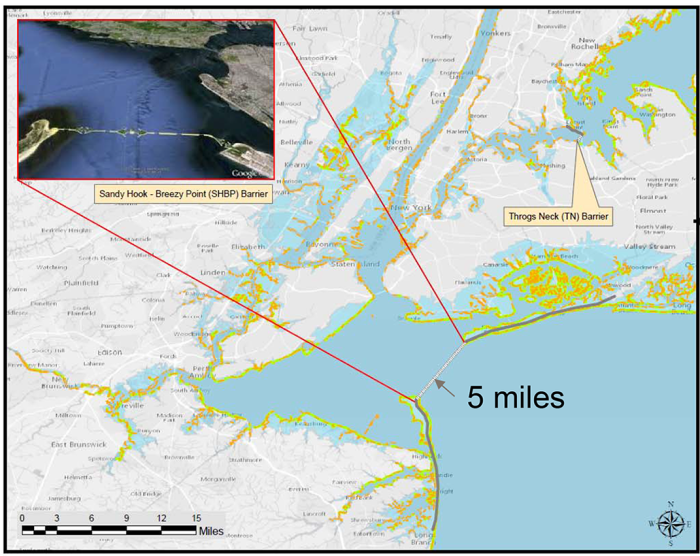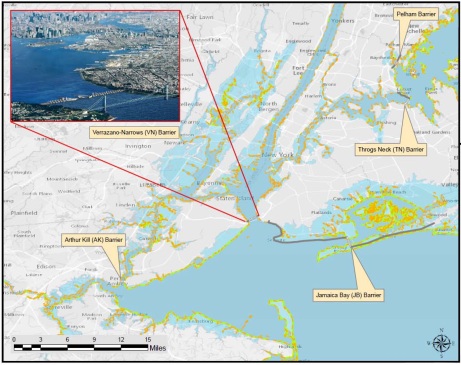The comment period for a set of proposals seeking to erect storm surge defenses in New York City Harbor that environmental groups have warned could have catastrophic effects on the Hudson River has been extended by 30 days.
The extension comes after a slew of Hudson Valley politicians submitted letters requesting the period be extended and for more public engagement.
The set of six proposals seek to stop another Superstorm Sandy through a variety of on-shore and in-water barriers meant to block storm surges. Environmental groups agree the problem should be addressed, but are fighting against the in-water barriers, especially those found in the second and third options, which would cut the Hudson River off from the Atlantic through a series of sea-walls and gated storm surge barriers.
The comment period was extended until Sept. 20, according to an email sent by the U.S. Army Corps of Engineers (USACE), “[d]ue to the interest generated by the public, at meetings and through their elected officials.”
The USACE is considering the proposals with New York and New Jersey and expect to winnow down the six options to the “1-2 that show (the) greatest promise for maximum net economic benefits by late Fall 2018,” according to USACE spokesman Michael T. Embrich.
For more on the proposals, click here.
The Hudson Valley environmental groups Riverkeeper and Scenic Hudson have railed against the options cutting off the Hudson from the Atlantic, with Riverkeeper Vice-President for Advocacy John Lipscomb saying they would have “catastrophic consequences.”
The surge barriers would halt the migratory patterns of a variety of fish, cause pollutants to back up in New York Harbor, and constrict the “natural respiration” of seawater flowing up the tidal river, according to Riverkeeper.
The surge barriers in the two options most concerning the groups would have their gates open except in stormy conditions, according to Embrich, but it is not known how wide the opened passages would be, and Lipscomb questioned how much of the longest barrier — which would stretch 5 miles from Queens to New Jersey — could possibly be gated.
Riverkeeper also expressed concerns about the gates’ closures during storms backing up water trying to escape from upstream, causing it the Hudson River to flood, which Embrich called a “significant design consideration” during the winnowing-down process.
These in-water surge barriers would do absolutely nothing to address the elephant in the room, according to the environmental groups: flooding from sea-level rise.
The USACE added 30 days to the original 45-day public comment period after receiving letters from Hudson Valley politicians on the federal, state and local level requesting an extension and more public engagement.
Congresswoman Nina Lowery wrote that “we must not rush into construction and permanent change to the nature of the river until we have public approval to proceed,” while Congressman Sean Patrick Maloney urged the USACE to hold additional information meetings, writing that “every community member impacted by this project should have the opportunity to be part of the conversation.”
New York state Senators Sue Serino, Terrance Murphy and Elaine Phillips also wrote letters expressing their concerns.
The USACE did not respond to an e-mail asking about the number of comments so far received.
Monna Jo Greene, environmental action director for the advocacy group Hudson River Sloop Clearwater, expressed concerns about whether enough information was being considered during the winnow-down process, but said her organization had not yet taken a position.
Greene attended an information meeting with the public held by the USACE in Poughkeepsie last month, and said an official responded to a question about the expense of the project’s environmental impacts by saying the project did not have an environmental economist.
She also expressed concerns about the impact the project would have on wetlands, which soak up the greenhouse gas carbon dioxide.

The proposals are being studied in an effort to protect the New York metro area from storm surges, such as those produced by Superstorm Sandy in 2012.
Though there were many issues with the proposals and how they were being studied, Lipscomb said, the “core problem” was the federal government had asked the USACE to address flooding from storm surges, and not from both storm surges and sea-level rise.
The slow rise of the Atlantic would be pushed passed the surge barriers whenever their gates were open, and the New York City Harbor and the Hudson River, which is at sea level until the Troy Federal Dam, would be affected at the same rate as the coasts.
“Essentially, they were asked about half the problem,” Lipscomb said. “…when you ask the wrong question, you get the wrong answer, and the [USACE] from the very start has begun answering the wrong question.”
Projects addressing flooding from both sea-level rise and storm surges, such as on-shore barriers, were the best option, he said, and any alternatives that would restrict the tidal flow of the Hudson “is a holy war for us.”
He compared it to the 2017 proposal to anchor up to 43 oil barges along the Hudson, which is now shelved.
“I can’t tell you how concerned I am about an oil spill,” Lipscomb said, “but the river will recover from an oil spill — it might take 100 years, 200 years, 300 years, (but) it will recover from an oil spill. It will not recover from barriers.”
Riverkeeper has set up a form to submit comments on the proposal. It can be found here. For more on the issue, click here.



